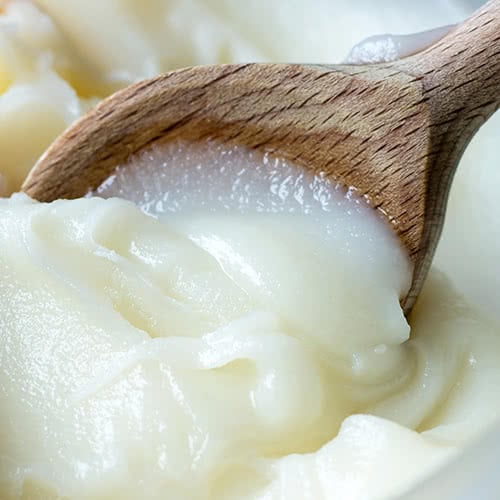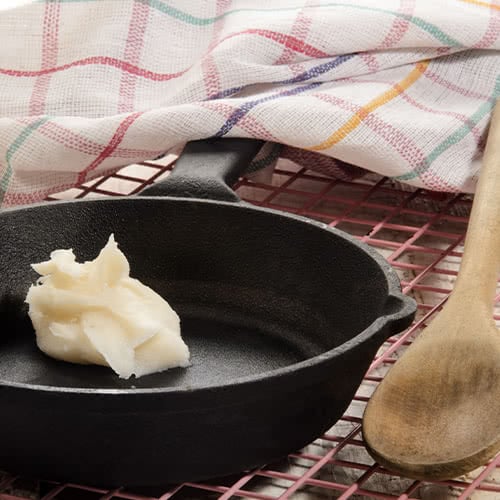What Is Lard?
Lard is the semi-soft, white fat located in the fattiest portions of a pig. Used as a cooking fat for centuries, lard fell out of favor when hydrogenated vegetable shortening was invented in the early 20th century. We now know that hydrogenated fats, also called trans fats, may increase the risk of heart disease. Lard has become a popular cooking fat once again because it contains no trans fats and offers a number of benefits.
What Is Lard Made Of?

Lard is made of 100% pork fat. It's separated from the fatty parts of a pig through a process called rendering. Portions like the pork belly, pork butt, or pork shoulder will render the most lard. The separated fat is solid and opaque at room temperature and turns into a clear liquid at around 95 to 113 degrees Fahrenheit, depending on its purity.
What Is Rendering?
Rendering is the process used to extract lard from fatty tissue. To perform rendering, the tissue or meat is cooked slowly until the fat turns into a melted liquid. The liquid fat can be separated from the solids and used for cooking. Rendering is easy to do at home and only requires a fatty cut of pork and a dependable pot or pan.
What Is Leaf Lard?
Leaf lard is a special type of lard that comes from a leaf-shaped portion of fat around a pig's kidneys. Considered the choicest lard available, leaf lard is softer and creamier than other types of lard. It's prized for its smooth consistency and is commonly used for baking. The best way to obtain leaf lard is through your local butcher or by rendering the fat yourself.
Is Lard Bad For You?

When used sparingly, lard is not particularly worse for you than other cooking fats. In fact, cooking with lard has many benefits, and more chefs are choosing lard over other traditional cooking oils or shortening.
- Pure lard has a neutral taste and contains no pork flavor
- Lard contains no trans fats, which makes it a healthier option than hydrogenated fats
- Lard has less saturated fat and cholesterol than butter
- Lard contains healthy monounsaturated fats, just like olive oil
- It has a high smoke point, making it ideal for frying foods
How to Use Lard?
Lard is just as versatile as any other cooking fat and can be used for roasting, grilling, sauteeing, frying, and baking. In its solid form it can be used just like butter or shortening and added to baking recipes. Use a small amount to grease a pan, or add it by the cup full to your cast-iron skillet for deep frying. It can even be spread onto toast.
What Can I Cook with Lard?
Lard can be used to cooked a wide variety of foods, but these are some common items prepared with lard:
- Fried Chicken - Lard is ideal for frying chicken because of its high smoke point
- Tamales - Tamales are traditionally made with whipped lard for the best texture
- Pie crust - Many bakers attest that lard produces the flakiest pie crust
- Biscuits - Use lard for flaky, defined layers in your biscuits
- Donuts - Donuts deep-fried in lard are crisp on the outside and soft in the middle
Lard vs Butter

Lard and butter are both used in baked goods, but there are some properties of lard that make it a favorite of many bakers. The melting point of lard is lower than butter, which means that more air and steam are released during bake times. This results in greater leavening and a flakier texture in baked goods. Lard also has larger fat crystals that leave open spaces as they melt, creating more layers than you would achieve with butter. For biscuits and pie crusts, lard, or a combination of lard and butter produce the ideal texture.
Lard vs Shortening
The difference between lard and vegetable shortening is that lard is made of pure animal fat and shortening is made of vegetable oil. When vegetable shortening was invented in 1911, it was very appealing because it was affordable and shelf stable. It could also be used in place of lard with very similar results. Shortening behaves the same way as lard in baking, producing flaky layers. However, shortening doesn't impart the same flavor or richness as lard.
What Is a Substitute for Lard?
If lard isn't available to you, there are other cooking fats that you can use in your recipes instead:
- Shortening - Shortening is made of 100% fat, just like lard. Use a 1:1 ratio when substituting shortening.
- Butter - Butter is only made of 80% fat, so if you are substituting butter for lard, you'll need a little extra butter. For every 1/4 cups of lard needed, use 1/4 cup butter plus 1 tablespoon.
- Vegetable oil- Use a 1:1 ratio for olive or coconut oil. For vegetable oil, substitute a 7/8 cup for 1 cup of lard.
When choosing a cooking fat, don't count out lard as an option. It contains less saturated fat than butter and unlike vegetable shortening, it has no trans fats. Lard produces crumbly, flaky pie crusts and tender, moist baked goods. Not only that, it's affordable and can be rendered in your own kitchen.



